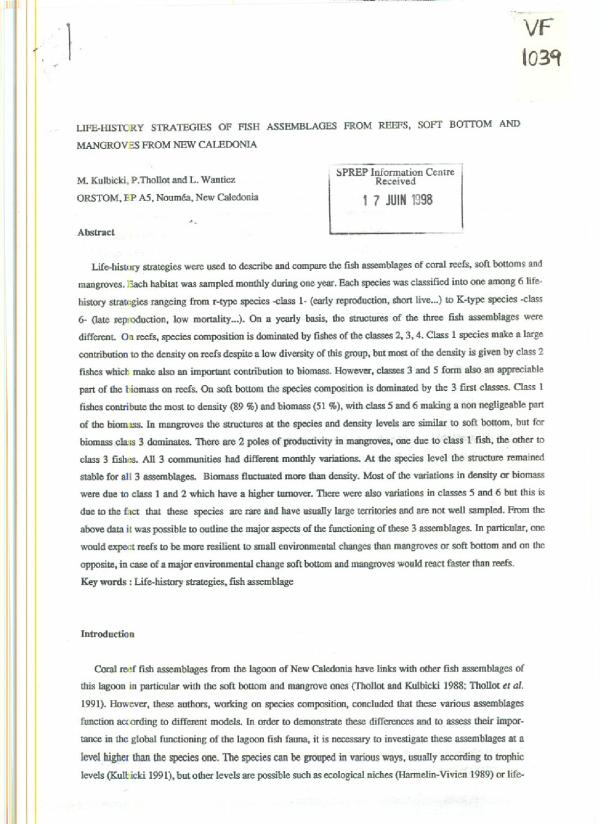Location
SPREP LIBRARY
Publisher
Secretariat of the Pacific Regional Environment Programme (SPREP)
Publication Year:
1991
Publication Place
Noumea, New Caledonia
Physical Description:
20 p. ; 30 cm.
Call Number
VF 1039 (EL)
Material Type
Language
English
Record ID:
8242
Legacy PEIN ID:
48121
General Notes
Kept in the Vertical File|SLIC also holds an e-copy in "FL" field
Available online
Subject Heading(s)
Life (biology)
Habitat (Ecology)-New Caledonia
Habitat conservation-New Caledonia
Habitat (Ecology)-Modification
Abstract
Life-history strategies were used to describe and compare the fish assemblages of coral reefs, soft bottoms and mangroves. Each habitat was sampled monthly during one year. Each species was classified into one among 6 life- history strategies rangeing from r-type species -class 1- (early reproduction, short live...) to K-type species class 6- (late reproduction, low mortality...). On a yearly basis, the structures of the three fish assemblages were different. On reefs, species composition is dominated by fishes of the classes 2,3,4. Class 1 species make a large contribution to the density on reefs despite a low diversity of this group, but most of the density is given by class 2 fishes which make also an important contribution to biomass. However, classes 3 and 5 form also an appreciable pan of the biomass on reefs. On soft bottom the species composition is dominated by the 3 first classes. Class 1 fishes contribute the most to density (89 %) and biomass (51 %), with class 5 and 6 making a non negligeable part of the biom ass. In mangroves the structures at the species and density levels are similar to soft bottom, but for biomass class 3 dominates. There are 2 poles of productivity in mangroves, one due to class 1 fish, the other to class 3 fishes. All 3 communities had different monthly variations. At the species level the structure remained stable for all 3 assemblages. Biomass fluctuated more than density. Most of the variations in density or biomass were due to class 1 and 2 which have a higher turnover. There were also variations in classes 5 and 6 but this is due to the fact that these species are rare and have usually large territories and are not well sampled. From the above data it was possible to outline the major aspects of the functioning of these 3 assemblages. In particular, one would expect reefs to be more resilient to small environmental changes than mangroves or soft bottom and on the opposite, in case of a major environmental change soft bottom and mangroves would react faster than reefs. Key words : Life-history strategies, fish assemblage
Location
SPREP LIBRARY
Publisher
Secretariat of the Pacific Regional Environment Programme (SPREP)
Publication Year:
1991
Publication Place
Noumea, New Caledonia
Physical Description:
20 p. ; 30 cm.
Call Number
VF 1039 (EL)
Material Type
Language
English
Record ID:
8242
Legacy PEIN ID:
48121
General Notes
Kept in the Vertical File|SLIC also holds an e-copy in "FL" field
Record Created: 17-Jun-1998
Record Modified: 05-Nov-2025
